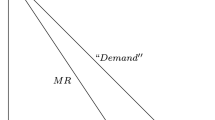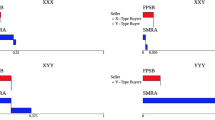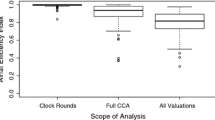Abstract
An auction framework is examined where each seller is uncertain about whether or not he will have a good available to sell. A timely example includes the auctioning off of radio spectrum by licensed primary users to unlicensed secondary users. A licensed primary user may not use the spectrum all of the time, but may not know in advance whether or not he will need the spectrum himself and thus whether or not he will have spectrum bandwidth available to rent out. We consider two types of auctions: an ex-post auction which takes place after each seller learns about the availability of the good and an ex-ante auction which takes place before each seller learns about availability. The expected payoffs to buyers, sellers, and to society are then compared. The ex-ante auction can cause buyers to bid on multiple expected units to ensure that they end up with at least one actual unit. Such over purchasing can create a loss to society. Sellers will prefer the ex-post auction since if fewer units are actually available to sell, then they can be sold at a higher price. Whereas in the ex-ante auction all sellers have one expected unit available to sell which results in a lower price. However, if high value buyers are common, then a buyer may prefer the ex-ante auction as it can be easier to win an expected unit than an ex-post actual unit. In contrast, if a buyer has a high valuation and if high value buyers are uncommon, then he may prefer the ex-post auction since he has a strong chance to win an actual unit.
Similar content being viewed by others
Notes
An example of an advance sale of spectrum is the FCC’s current auctioning of advanced wireless services spectrum where federal users have to clear the spectrum for non-federal use. However, the auction is held prior to all federal users being cleared, thus a non-federal bidder may end up with unusable spectrum.
Spectrum could be sold in real time using an auction where the good auctioned off could be just minutes or hours of spectrum use; this short-term auction could be implemented by cognitive or smart radio, as introduced by Mitola and Maguire (1999). Alternatively, the auction could take place a few hours in advance; here, there would be uncertainty regarding the spectrum’s availability as it is always possible that the primary user would need to use the spectrum himself for unforeseen communication, defense, or aviation purposes.
In a report to the President, PCAST (2012) recommends short-term auctions for temporary access to federal spectrums not being used by different federal agencies where the federal legacy would retain priority access to the spectrum. It is recommended in the report that such auctions take place through a spectrum management center or centralized authority, although non-centralized distributed management models are discussed in Zhang et al. (2013).
For further discussion of capacity constraints see Che et al. (2013).
Note that the model could easily be rewritten as one with a single seller of multiple units of the good. We choose to have multiple sellers as our examples of agricultrual products and radio spectrum sharing would involve multiple sellers. Additionally, the assumption of multiple sellers does not add much to the bulkiness of the model and results.
References
Ausubel LM (2004) An efficient ascending-bid auction for multiple objects. Am Econ Rev 94(5):1452–2475
Babaioff M, Blumrosen L, Roth AL (2010) Auctions with online supply. In: EC 2010 proceedings of the 11th ACM conference on electronic commerce, pp 13–22
Banks JS, Ledyard JO, Porter DP (1989) Allocating uncertain and unresponsive resources: an experimental approach. RAND J Econ 20(1):1–25
Bulow J, Klemperer P (1996) Auctions versus negotiation. Am Econ Rev 86(1):180–194
Brown C, Miller S (2008) The impacts of local markets: a review of research on farmers markets and community supported agriculture (CSA). Am J Agric Econ 90(5):1298–1302
Che YK, Kim J, Mierendorff K (2013) Generalized Reduced-form auctions: a network-flow approach. Econometrica 81(6):2487–2520
Chun SH, La RJ (2013) Secondary spectrum trading: auction-based framework for spectrum allocation and profit sharing. IEEE/ACM Trans Netw 21(1):176–189
Coase RH (1959) The federal communications commission. J Law Econ 2:1–40
Engelman R et al (2002) Report of the spectrum efficiency working group. In: Federal communications commission spectrum policy task force
Gandhi S, Buragohain C, Cao L, Zheng H, Suri S (2007) A general framework for wireless spectrum auctions. In: 2nd IEEE international symposium on new frontiers in dynamic spectrum access networks, pp 22–33
Gelabert X et al (2010) Spectrum sharing in cognitive radio networks with imperfect sensing: a discrete-time Markov model. Comput Netw 54(14):2519–2536
Jeitschko TD (1999) Equilibrium price paths in sequential auctions with stochastic supply. Econ Lett 64:67–72
Kasbekar GS (2011) Economics of spectrum allocation in cognitive radio networks. Ph.D. dissertation, Electrical and Systems Engineering, University of Pennsylvania, Philadelphia
Kasbekar GS, Sarkar S (2011) Spectrum pricing games with arbitrary bandwidth availability probabilities. In: IEEE international symposium on information theory proceedings, pp 2711–2715
Kim H et al (2012) On the impact of outdated channel information on the capacity of secondary user in spectrum sharing environments. IEEE Trans Wireless Commun 11(1):284–295
Kranton RE, Minehart DF (2001) A theory of buyer-seller network. Am Econ Rev 91(3):485–508
Maharjan S, Zhang Y, Gjessing S (2011) Economic approaches for cognitive radio networks: a survey. Wireless Pers Commun 57:33–51
McHenry MA et al (2006) Chicago spectrum occupancy measurements and analysis and a long-term studies proposal. In: Proceedings of the first international workshop on technology and policy for accessing spectrum. ACM New York
McMillan J (1994) Selling spectrum rights. J Econ Perspect 8(3):145–162
Milgrom P (2000) Putting auction theory to work: the simultaneous ascending auction. J Polit Econ 108(2):245–272
Milgrom P (2011) The case for unlicensed spectrum. Stanford Institiute for Economic Policy Research Discussion Paper No. 11-002
Milgrom PR, Weber RJ (1982) A theory of auctions and competitive bidding. Econometrica 50(5):1089–1122
Mitola J III, Maguire GQ Jr (1999) Cognitive radio: making software radios more personal. IEEE Pers Commun 6(4):13–18
Neugebauer T, Pezanis-Christou P (2007) Bidding behavior at sequential first-price auctions with(out) supply uncertainty: a laboratory analysis. J Econ Behav Organ 63:55–72
PCAST (2012) Report to the president: realizing the full potential of government-held spectrum to spur economic growth. Executive Office of the President, President’s Council of Advisors on Science and Technology
Riley JG, Samuelson WF (1981) Optimal auctions. Am Econ Rev 71(3):381–392
Rodriguez GE (2012) Sequential auctions with imperfect quantity commitment. Econ Theory 49:143–173
Vickrey W (1961) Counterspeculation, auctions, and competitive sealed tenders. J Finance 16(1):8–37
Wang B, Wu Y, Liu KJR (2010) Game theory for cognitive radio networks: an overview. Comput Netw 54:2537–2561
Wilkinson J (2001) Community supported agriculture. OCD Technote 20:1–2
Zhang Y et al (2013) Auction approaches for resource allocation in wireless systems: a survey. IEEE Commun Surv Tutorials 15(3):1020–1041
Zeithammer R (2009) Commitment in sequential auctioning: advance listings and threshold prices. Econ Theory 38:187–216
Acknowledgments
Financial support from the NSF under Grant SES-1343380 is gratefully acknowledged. Special thanks to Xiangwei Zhou and three anonymous referees for helpful comments and suggestions and to Markum Reed for invaluable research assistance.
Author information
Authors and Affiliations
Corresponding author
Appendix
Appendix
In the ex-ante auction, we say that a buyer bids sincerely if for all \(\kappa \in \{1,2,\ldots ,m\}\) he drops out of the auction for the \(\kappa \)th expected unit when the bidding equals his \(\kappa \)th expected value.
Proposition 7 shows that in the ex-ante auction buyers have incentive to bid sincerely. Note that Ausubel (2004)’s Theorem 2 shows that as long as long as a full support assumption is met sincere bidding is the unique outcome of the iterated elimination of weakly dominated strategies and Ausubel’s Theorem 1 proves that sincere bidding by all bidders is an ex post perfect equilibrium. Ausubel introduces the full support assumption in a model where the buyers’ marginal valuations are integer valued while these valuations are continuous random variables in the current paper. Although Ausubel states that Theorems 1 and 2 hold in the continuous case, the proofs are omitted for brevity and so we provide a proof. Ausubel’s full support assumption guarantees that every bid matters or that given any bid b there is a positive probability that the next bid will be directly above or below bid b. Our valuations also satisfy this assumption (with no additional condition necessary) as the expected value of the \(\kappa \)th expected unit to buyer j is \((1-q)^{\kappa -1}q\cdot v_{j}.\) Since every \(v_{j}\) is a continuous random variable over \([\underline{v},\bar{v}]\), j’s marginal valuation for the \(\kappa \)th unit is a continuous random variable over \((1-q)^{\kappa -1}q\cdot [\underline{v},\bar{v}]\) and thus there is always a positive probability that the next sincere bid is directly above or below any \(b\in (1-q)^{\kappa -1}q\cdot (\underline{v},\bar{v})\).
Proposition 7
Assume the auction is ex-ante. For each buyer j the strategy, to remain in the bidding for \(\kappa \) units up to j’s valuation for the \(\kappa \)th expected unit, is a perfect Bayesian equilibrium and follows the iterated elimination of weakly dominated strategies.
Proof
First, we show that the proposed strategy is a perfect Bayesian equilibrium or that bidder j will bid sincerely if everyone else bids sincerely. Clearly bidder j will not bid above his expected value for an expected unit. We just need to show that he also will not bid below his expected value for a unit. Assume to the contrary that bidder j sets a maximum bid of \(b<(1-q)^{\kappa -1}q\cdot v_{j}\) for the \(\kappa \)th unit; this is only advantageous to j if he can get a lower price on one of his other units which will only occur if j clinches a unit at price b. Let j drop out at price b and let an expected unit be clinched at this price. Thus, at price \(b-\varepsilon \) demand was greater than supply and aggregate demand of all bidders excluding k was also greater than aggregate supply for all k. At price b, j decreases his demand by one as this is his maximum bid for the \(\kappa \)th expected unit; additionally, we assume that a unit is clinched. However, as j has decreased his demand he cannot clinch the good unless another bidder also decreases his demand at price b. Since we assume that the expected valuations are continuous the probability that two bidders drop out at the same time is zero; thus, it must be that the good is not clinched by j. So, j does not gain by dropping out of the auction for the \(\kappa \)th good before \((1-q)^{\kappa -1}q\cdot v_{j}\). Therefore, no j has incentive to deviate from our strategy.
Second, we show that the proposed strategies are an equilibrium following the iterated elimination of weakly dominated strategies. Consider any history such that the aggregate demand of all bidders equals \((m+1)\) at the current price. We show that bidder j does best to bid sincerely by demonstrating that j will not drop out of the auction for the \(\kappa \)th expected unit at \(b<(1-q)^{\kappa -1}q\cdot v_{j}\). Assume that j is only bidding on one unit or that \(\kappa =1\). If j drops out at price b, then he may not win the expected unit and since b is below his marginal valuation for the unit he is better off waiting until the price equals his marginal valuation. Now assume that j is bidding on at least two units or that \(\kappa \ge 2\). If j decreases his demand by one unit at price b, then the aggregate demand will decrease to m, the market will clear, and j will win \(\kappa -1\) expected units at price b. However, if j does not change his demand at price b and if another bidder changes his demand at price \(b+\varepsilon \) then j will win \(\kappa \) units at price \(b+\varepsilon \) which he prefers to winning \(\kappa -1\) units at price b. Since there is a positive probability that another bidder will change his demand at price \(b+\varepsilon \), bidder j prefers to not drop out at price b. Additionally, bidder j will never choose to drop out of the auction for the \(\kappa \)th good at price \(b'>(1-q)^{\kappa -1}q\cdot v_{j}\). If j follows this strategy and if another bidder lowers his demand at price p such that \((1-q)^{\kappa -1}q\cdot v_{j}<p<b'\), then j would win \(\kappa \) units at price p; this price is above his marginal valuation for the \(\kappa \)th good. Since there is a positive probability that another bidder will drop out at p, bidder j will not drop out at price \(b'\). Thus, bidder j does best to bid sincerely and the insincere strategies can be eliminated.
Next consider any history such that the aggregate demand of all bidders equals \((m+2)\) at the current price. Let bidder j set his maximum bid for the \(\kappa \)th item at \(b<(1-q)^{\kappa -1}q\cdot v_{j}\). If j decreases his demand by one at price b, then either the aggregate demand will equal \((m+1)\) and we will go to the case described above or a buyer \(k\ne j\) will clinch a good at price b and aggregate demand will decrease to m while available supply will equal \((m-1)\). Either way we return to the first situation described above where aggregate demand minus aggregate supply equals one. However, if j stays in the auction until the bidding reaches his marginal valuation, then there is a positive probability that someone else will decrease his bid and that j will clinch a unit. Thus, it is not beneficial to j to drop out at price b which is below his marginal valuation. Additionally, j will not want to bid above his marginal valuation as there is a positive probability that he will end up purchasing the unit at a price above his marginal valuation. So j’s best strategy is to bid sincerely. We can continue this process to show that for any aggregate demand greater than m, j’s best strategy is to bid sincerely and the iterated elimination of weakly dominated strategies will yield a strategy of bidding sincerely. \(\square \)
Rights and permissions
About this article
Cite this article
Watts, A. Two ways to auction off an uncertain good. J Econ 119, 1–15 (2016). https://doi.org/10.1007/s00712-016-0483-7
Received:
Accepted:
Published:
Issue Date:
DOI: https://doi.org/10.1007/s00712-016-0483-7




